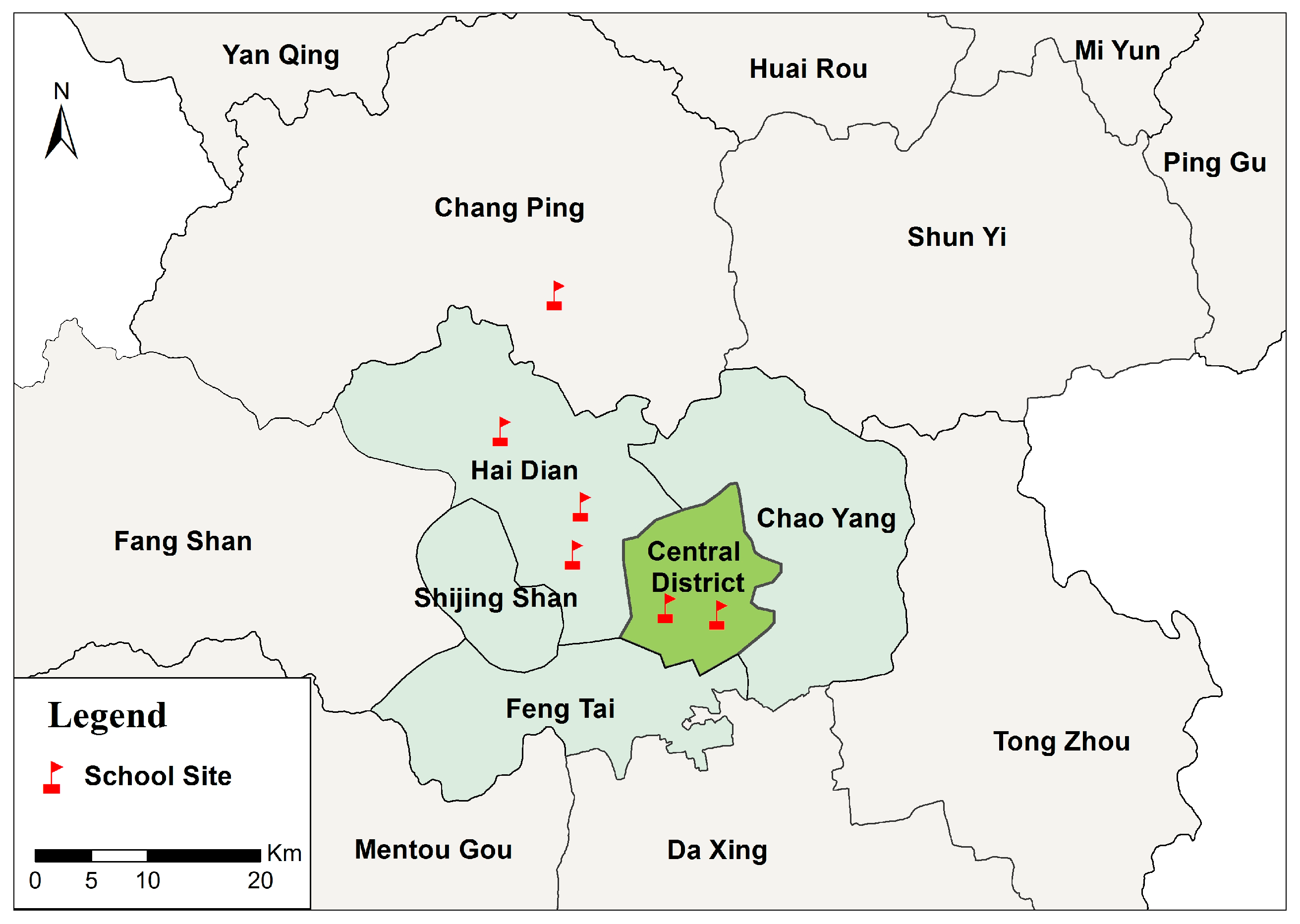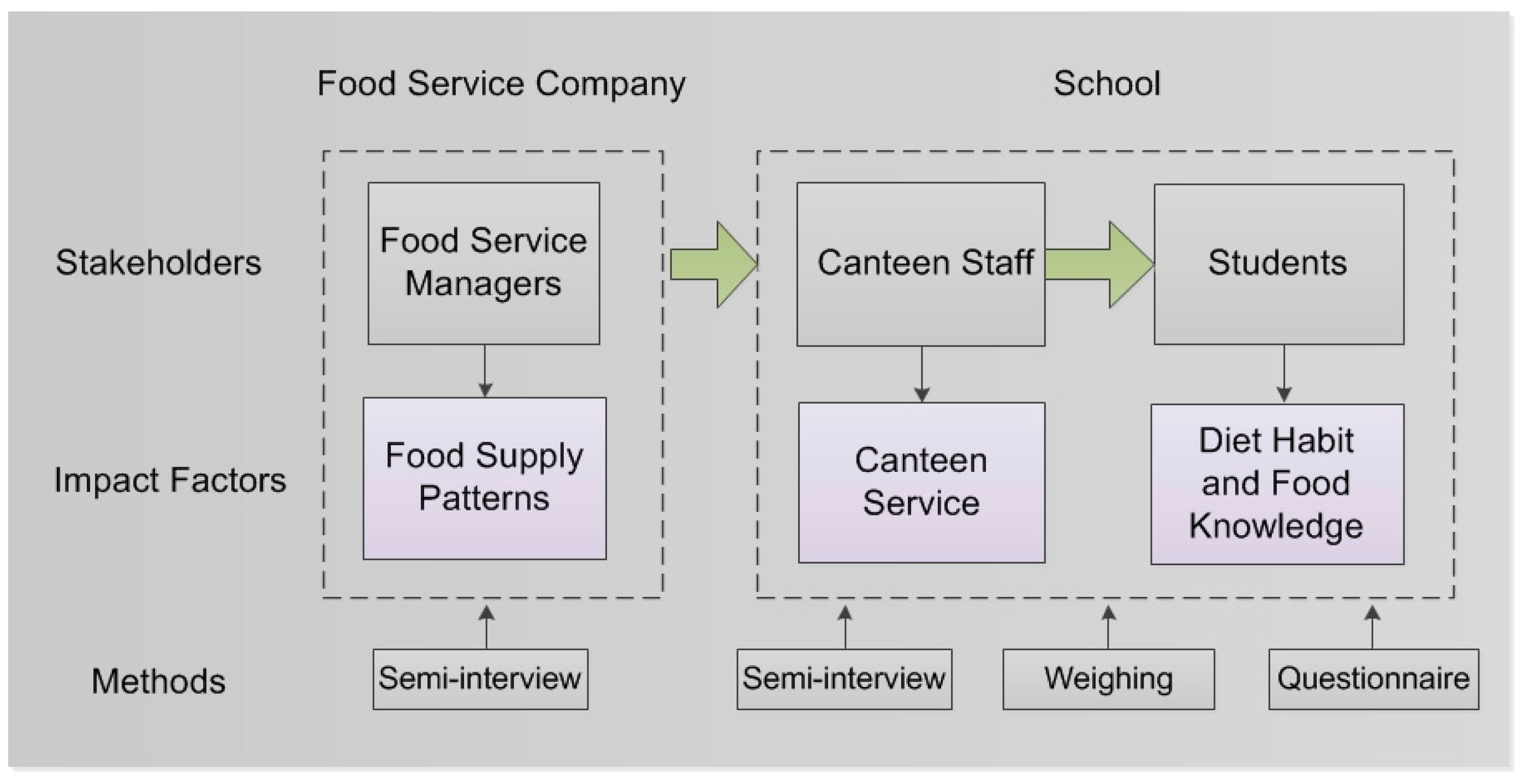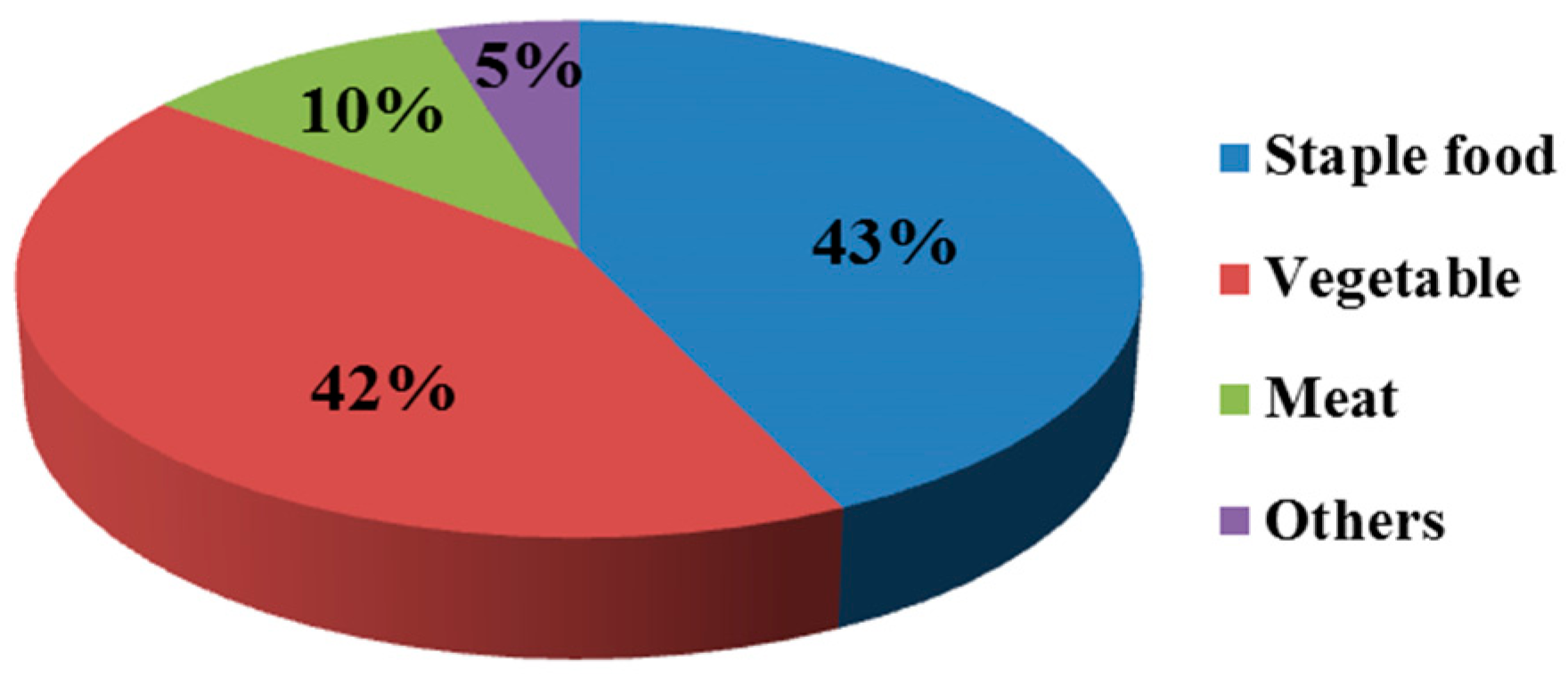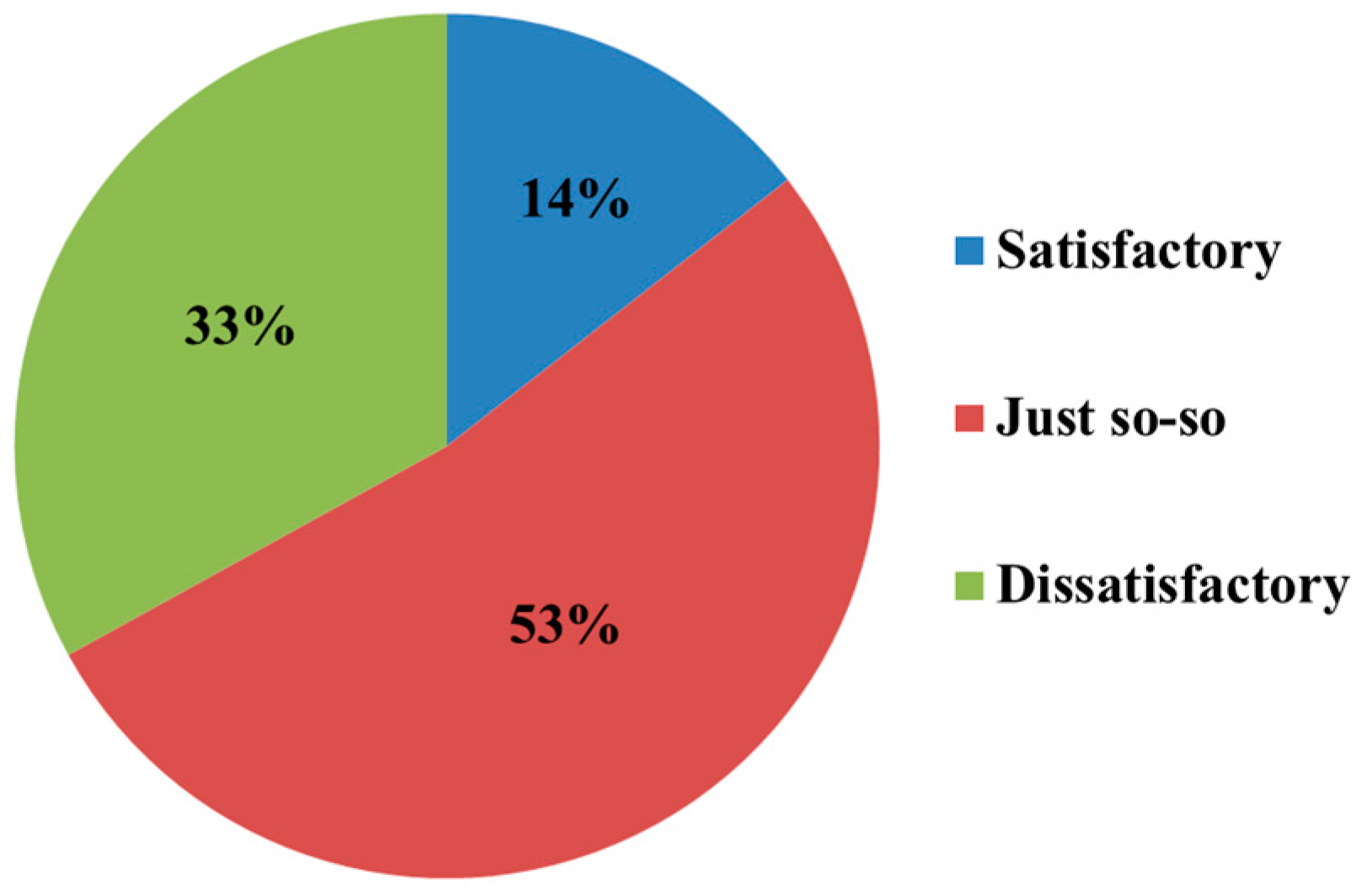Plate Waste in School Lunch Programs in Beijing, China
Abstract
:1. Introduction
2. Materials and Methods
2.1. Sample Selection
2.2. Data Collection
2.2.1. Food Waste Measurement
- For packed meals: we randomly selected 100 boxes of packed meals after lunch and measured each edible food item left in the box by physical weighing.
- For buffet and set meals: all of the waste after lunch was mixed together and discarded into large bins. Therefore, we used a proxy by dividing the total weight of the bin by the number of students (counted by trained observer) who had discarded their food in it. Then, we stirred the bin of food waste evenly and poured them into small basins, where we classified the composition of food waste with the assistance of experienced kitchen staff.
2.2.2. Questionnaire Survey
- Demographic background: age, gender, height, and weight;
- Dietary habit: taste preference, snack food preference, picky dietary habit, frequency of dining outside during school time, favorite dining places outside, and habit of taking doggie bags;
- Attitude and knowledge: general awareness of food waste, view on school canteen service, view on the risk of food shortage in China, knowledge of food production, knowledge of water, mineral, and energy scarcity, attitude on environmental protection, attitude on frugality tradition, and nutrition consideration in food choice.
2.2.3. Semi-Structured Interview
3. Results
3.1. Food Waste Disparity under Different Food Supply Patterns
3.2. Deficiency of Canteen Service
3.3. Dietary Habit and Knowledge of Food Production
4. Discussion and Conclusions
4.1. Uncertainties and Implications of Our Results
4.2. Comparison with Other Studies
4.3. Policy Recommendations
- (i)
- To increase food supply efficiency and promote buffet meals in schools. The long distance and consequent transportation time (on average 2 to 3 h in Beijing) to deliver food from supply companies to students result in a degradation of the freshness, color attractiveness, and taste of off-site school lunches. Such declining of lunch quality leads further to the increase of plate waste and the frequency of outside-school food consumption. Food supplied from school kitchen or pre-processed food cooked on-site should be encouraged to reduce food waste (as a result of more efficient food supply and more accurate and timely demand estimation [36]). Buffet meals—which cause less plate waste than packed meals and set meals—should be promoted for school lunches.
- (ii)
- To improve the quality of school canteen service. The school canteen is the main food service institution in schools, and plays a significant role in plate waste reduction. More regular communication among food suppliers, canteen staff, school teachers, and students (e.g., in the form of a “school lunch committee”) may help react immediately to feedback from students on canteen service and food taste, and thus improve the canteen service and reduce plate waste. For large-scale school canteens, introducing market competition in food supply may push forward the reform of canteen management and improve the quality of service. Additional assistance, including financial support and guidance from schools and the government are also necessary to implement good practices such as nutrition labels and food saving and waste reduction tips; e.g., table cards with a note “take small portions and many times” in canteens [37,38].
- (iii)
- To join efforts of schools and families to ensure a better knowledge of food production and a healthier dietary habit of students. Adolescence is a critical stage in one’s lifetime in the cultivation of a healthy dietary habit. Dietary education on food supply, food culture, and nutrition balance should be introduced as part of schools’ standard curriculum [39,40]. This may also include various agricultural practices, such as visiting farmland and participating in farming and planting in their spare time. At home, involving children in cooking is a good way to familiarize them with food nutrition and the value of food. Supervision and correction of children’s bad dietary habit and education on Chinese tradition of “saving food” both at schools and at home are also necessary [41,42].
Acknowledgments
Author Contributions
Conflicts of Interest
References
- Gustavsson, J.; Cederberg, C.; Sonesson, U.; van Otterdijk, R.; Meybeck, A. Global Food Losses and Food Waste—Extent, Causes and Prevention; FAO: Rome, Italy, 2011. [Google Scholar]
- Cuellar, A.D.; Webber, M.E. Wasted Food, Wasted Energy: The Embedded Energy in Food Waste in the United States. Environ. Sci. Technol. 2010, 44, 6464–6469. [Google Scholar] [CrossRef] [PubMed]
- Kummu, M.; de Moel, H.; Porkka, M.; Siebert, S.; Varis, O.; Ward, P.J. Lost food, wasted resources: Global food supply chain losses and their impacts on freshwater, cropland, and fertiliser use. Sci. Total Environ. 2012, 438, 477–489. [Google Scholar] [CrossRef] [PubMed]
- Godfray, H.C.J.; Beddington, J.R.; Crute, I.R.; Haddad, L.; Lawrence, D.; Muir, J.F.; Pretty, J.; Robinson, S.; Thomas, S.M.; Toulmin, C. Food security: The challenge of feeding 9 billion people. Science 2010, 327, 812–818. [Google Scholar] [CrossRef] [PubMed]
- Vittuari, M.; de Menna, F.; Pagani, M. The Hidden Burden of Food Waste: The Double Energy Waste in Italy. Energies 2016, 9, 660. [Google Scholar] [CrossRef]
- Pimentel, D.; Pimentel, M. Food, Energy, and Society; CRC Press: Boca Raton, FL, USA, 2008. [Google Scholar]
- Liu, G. Food Losses and Food Waste in China: A First Estimate. OECD iLibrary 2014. [Google Scholar] [CrossRef]
- Liu, J.; Lundqvist, J.; Weinberg, J.; Gustafsson, J. Food losses and waste in China and their implication for water and land. Environ. Sci. Technol. 2013, 47, 10137–10144. [Google Scholar] [CrossRef] [PubMed]
- Xu, S.W. Food consumption and waste in China. Food Nutr. China 2005, 11, 6–10. (In Chinese) [Google Scholar]
- Buzby, J.C.; Guthrie, J.F. Plate waste in school nutrition programs. J. Consum. Aff. 2002, 36, 220–238. [Google Scholar] [CrossRef]
- Liao, W.K.; Zhang, X.; Zhang, H.; Hu, X.Q.; Ma, G.S. School health education, student nutrition practice and need assessment in China. Chin. J. Sch. Health 2002, 23, 6–8. (In Chinese) [Google Scholar]
- Cohen, J.F.W.; Richardson, S.; Austin, S.B.; Economos, C.D.; Rimm, E.B. School Lunch Waste among Middle School Students Nutrients Consumed and Costs. Am. J. Prev. Med. 2013, 44, 114–121. [Google Scholar] [CrossRef] [PubMed]
- Byker, C.J.; Farris, A.R.; Marcenelle, M.; Davis, G.C.; Serrano, E.L. Food Waste in a School Nutrition Program After Implementation of New Lunch Program Guidelines. J. Nutr. Educ. Behav. 2014, 46, 406–411. [Google Scholar] [CrossRef] [PubMed]
- Waste and Resources Action Programme (WRAP). Food Waste in Schools; WRAP Publishing: Banbury, UK, 2011. [Google Scholar]
- Falasconi, L.; Vittuari, M.; Politano, A.; Segrè, A. Food waste in school catering: An Italian case study. Sustainability 2015, 7, 14745–14760. [Google Scholar] [CrossRef]
- Silvennoinen, K.; Heikkilä, L.; Katajajuuri, J.-M.; Reinikainen, A. Food waste volume and origin: Case studies in the Finnish food service sector. Waste Manag. 2015. [Google Scholar] [CrossRef] [PubMed]
- Ishdorj, A.; Capps, O., Jr.; Murano, P.S.; Capps, O.J. Nutrient Density and the Cost of Vegetables from Elementary School Lunches. Adv. Nutr. 2016, 7, 254S–260S. [Google Scholar] [CrossRef] [PubMed]
- Ferreira, M.; Liz Martins, M.; Rocha, R. Food waste as an index of food service quality. Br. Food J. 2013, 115, 1628–1637. [Google Scholar] [CrossRef]
- Martins, M.L.; Cunha, L.M.; Rodrigues, S.; Rocha, A. Determination of plate waste in primary school lunches by weighing and visual estimation methods: A validation study. Waste Manag. 2014, 34, 1362–1368. [Google Scholar] [CrossRef] [PubMed]
- Wansink, B.; van Ittersum, K.; Payne, C.R. Larger bowl size increases the amount of cereal children request, consume, and waste. J. Pediatr. 2014, 164, 323–326. [Google Scholar] [CrossRef] [PubMed]
- Getlinger, M.J.; Laughlin, C.V.; Bell, E.; Akre, C.; Arjmandi, B.H. Food waste is reduced when elementary-school children have recess before lunch. J. Am. Diet. Assoc. 1996, 96, 906–908. [Google Scholar] [CrossRef]
- Casimir, J. Food Waste at the School Level. Master’s Thesis, Department of Earth Sciences, Uppsala University, Uppsala, Sweden, 2014. [Google Scholar]
- Marlette, M.A.; Templeton, S.B.; Panemangalore, M. Food type, food preparation, and competitive food purchases impact school lunch plate waste by sixth-grade students. J. Am. Diet. Assoc. 2005, 105, 1779–1782. [Google Scholar] [CrossRef] [PubMed]
- Abe, K.; Akamatsu, R. Japanese children and plate waste: Contexts of low self-efficacy. Health Educ. J. 2014. [Google Scholar] [CrossRef]
- Cohen, J.F.W.; Liesbeth, A.S.; Ellen, P.; Austin, S.B.; Frazier, A.L.; Christina, D.E.; Eric, B.R. Long-Term Impact of a Chef on School Lunch Consumption: Findings from a 2-Year Pilot Study in Boston Middle Schools. J. Acad. Nutr. Diet. 2012, 112, 927–933. [Google Scholar] [CrossRef] [PubMed]
- Marc, A.A.; Robin, L.P.; Michelle, M.Z.; James, F.S. Salad Bars and Fruit and Vegetable Consumption in Elementary Schools: A Plate Waste Study. J. Am. Diet. Assoc. 2005, 105, 1789–1792. [Google Scholar]
- Cohen, J.F.W.; Richardson, S.; Parker, E.; Catalano, P.J.; Rimm, E.B. Impact of the New U.S. Department of Agriculture School Meal Standards on Food election, Consumption, and Waste. Am. J. Prev. Med. 2014, 46, 388–394. [Google Scholar] [CrossRef] [PubMed]
- European Commission (EC). Final Report–Preparatory Study on Food Waste across EU27; EC Publishing: Brussels, Belgium, 2010. [Google Scholar]
- Ishdorj, A.; Capps, O.; Storey, M.; Murano, P.S. Investigating the Relationship between Food Pairings and Plate Waste from Elementary School Lunches. Food Nutr. Sci. 2015, 6, 1029–1044. [Google Scholar] [CrossRef]
- Zhai, F.Y.; Cao, R.X.; Fu, J.J.; Wang, Z.H.; Zhang, L.W. Current status of nutritional lunch in primary and high schools of Beijing. Can. J. Public Health 2007, 1, 7–12. (In Chinese) [Google Scholar]
- Pan, Y.P.; Gao, A.Y.; Liu, L.J.; Li, L. Analysis of elementary and secondary school students’ nutrition lunch and its supply patterns in Dongcheng district of Beijing. Chin. J. School Health 2007, 28, 446–447. (In Chinese) [Google Scholar]
- Duan, J.L.; Pan, Y.P.; Teng, L.X.; Zhao, R.; Qin, Y. Nutrition quality of self-feeding lunch in the primary and secondary schools in Beijing. Chin. J. School Health 2012, 33, 651–653. (In Chinese) [Google Scholar]
- Hanks, A.S.; Wansink, B.; Just, D.R. Reliability and accuracy of real-time visualization techniques for measuring school cafeteria tray waste: Validating the quarter-waste method. J. Acad. Nutr. Diet. 2014, 114, 470–474. [Google Scholar] [CrossRef] [PubMed]
- Wu, Y.; Wang, X.K.; Lu, F. Ecological footprint and water footprint of Beijng citizen food consumption. Resour. Sci. 2011, 33, 1145–1152. (In Chinese) [Google Scholar]
- Ryley, J.; Daniels, S.; Glew, G. Portion Sizes, Preparation and Cooking Yields, and Plate Waste in School Meals. Int. J. Food Sci. Nutr. 1979, 33, 170–178. [Google Scholar] [CrossRef]
- Ge, K.Y. The Nutritional Sciences of China; People’s Medical Publishing House: Beijing, China, 2004. (In Chinese) [Google Scholar]
- Jennifer, L.P.; Kelly, D.B. Legal and Public Health Considerations Affecting the Success, Reach, and Impact of Menu-Labeling Laws. Am. J. Public Health 2008, 98, 1578–1583. [Google Scholar]
- Wethington, H.; Maynard, L.M.; Blanck, H.M. Use of calorie information at fast food and chain restaurants among US youth aged 9–18 years, 2010. J. Public Health 2013, 35, 354–360. [Google Scholar] [CrossRef] [PubMed]
- Baik, J.Y.; Lee, H. Habitual plate-waste of 6-to 9-year-olds may not be associated with lower nutritional needs or tasteacuity, but undesirable dietary factors. Nutr. Res. 2009, 29, 831–838. [Google Scholar] [CrossRef] [PubMed]
- Gase, L.N.; McCarthy, W.J.; Robles, B.; Kuo, T. Student receptivity to new school meal offerings: Assessing fruit and vegetable waste among middle school students in the Los Angeles Unified School District. Prev. Med. 2014, 67, 28–33. [Google Scholar] [CrossRef] [PubMed]
- Junilla, K.L.; Roel, C.J.H.; Ester, F.C.S.; Rutger, C.M.E.; Jennifer, O.F.; Stef, P.J.K. How parental dietary behavior and food parenting practices affect children’s dietary behavior. Interacting sources of influence? Appetite 2015, 89, 246–257. [Google Scholar]
- Klesges, R.C.; Stein, R.J.; Eck, L.H.; Isbell, T.R.; Klesges, L.M. Parental influence on food selection in young children and its relationships to childhood obesity. Am. J. Clin. Nutr. 1991, 53, 859–864. [Google Scholar] [PubMed]






| Name | Category | Number of Students/Samples | Number of Boys/Girls | Age Ranges | Food Supply Pattern | ||
|---|---|---|---|---|---|---|---|
| 10–12 | 13–15 | 16–18 | |||||
| School 1 | Private | 1200/134 | 60/74 | 0 | 134 | 0 | Buffet meal |
| School 2 | Public | 1600/232 | 126/106 | 215 | 17 | 0 | Packed meal |
| School 3 | Public | 2500/180 | 82/98 | 4 | 96 | 80 | Set meal |
| School 4 | Public | 2800/145 | 51/94 | 0 | 34 | 111 | Set meal |
| School 5 | Public | 1000/110 | 55/55 | 9 | 40 | 61 | Packed meal |
| School 6 | Public | 4000/197 | 97/100 | 22 | 174 | 1 | Buffet meal |
| Supply Pattern | Food Waste (g/Cap/Meal) | Share of Food Served (%) | Food Waste Composition (g/Cap/Meal) | |||
|---|---|---|---|---|---|---|
| Staple Food | Vegetables | Meats | Others | |||
| Packed Meal | 216 | 35 | 84 | 105 | 24 | 3 |
| Buffet Meal | 63 | 10 | 45 | 12 | 3 | 3 |
| Set Meal | 109 | 18 | 39 | 49 | 10 | 11 |
| Average | 130 | 21 | 56 | 55 | 12 | 6 |
| Gender | Picky Dietary Habit | Snack Food Preference | ||||||
|---|---|---|---|---|---|---|---|---|
| Yes | No | Yes | No | |||||
| Person | Percentage | Person | Percentage | Person | Percentage | Person | Percentage | |
| Male | 174 | 39% | 269 | 61% | 320 | 73% | 119 | 27% |
| Female | 231 | 48% | 249 | 52% | 372 | 78% | 102 | 22% |
© 2016 by the authors; licensee MDPI, Basel, Switzerland. This article is an open access article distributed under the terms and conditions of the Creative Commons Attribution (CC-BY) license (http://creativecommons.org/licenses/by/4.0/).
Share and Cite
Liu, Y.; Cheng, S.; Liu, X.; Cao, X.; Xue, L.; Liu, G. Plate Waste in School Lunch Programs in Beijing, China. Sustainability 2016, 8, 1288. https://doi.org/10.3390/su8121288
Liu Y, Cheng S, Liu X, Cao X, Xue L, Liu G. Plate Waste in School Lunch Programs in Beijing, China. Sustainability. 2016; 8(12):1288. https://doi.org/10.3390/su8121288
Chicago/Turabian StyleLiu, Yao, Shengkui Cheng, Xiaojie Liu, Xiaochang Cao, Li Xue, and Gang Liu. 2016. "Plate Waste in School Lunch Programs in Beijing, China" Sustainability 8, no. 12: 1288. https://doi.org/10.3390/su8121288





